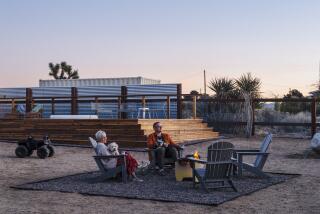Lights, Camera … : Production designer Suttirat Larlarb has edgy experience re-creating canyon in â127 Hoursâ
For Lights, Camera ⌠, we ask a craftsperson to talk about a specific scene in his or her latest film. This week, Suttirat Larlarb, production designer on â127 Hours,â writes about re-creating the Utah canyon in which rock climber Aron Ralston became trapped and in which actor James Franco was going to film some of his scenes portraying him.
--
[Director] Danny [Boyle]âs âmanifestoâ was that nothing should be convenient about the canyon set: The walls should not move to accommodate anything or anyone (lighting, cameras, crew), and it had to be an exact match to the real location, period. If nothing was convenient, there would be an omnipresent sense of urgency, momentum and occasionally frustration (!) in the midst of relentless stasis, which in turn would make our film breathe in the honesty of Aron Ralstonâs situation: simultaneously static and dynamic. There would be no visual relief from this one well-documented spot for the entirety of the film, meaning that the set would have to stand up to an immense amount of scrutiny. We needed as much visual information about the real canyon as possible in order to re-create it that closely.
We made a number of trips to Blue John Canyon to survey it. The journey begins with a five-hour drive from Salt Lake City to Moab, then a two-hour desert hike to the mouth of the slot canyon, in extreme heat or occasionally calf-deep snow, while carrying supplies and equipment. From this point, the real canyoneering begins: down-climbing, crawling under suspended boulders and twisting your body sideways into a series of narrow slots where the floor can be anywhere from 4 inches to 18 inches wide.
The spot where Aron was trapped comprises a relatively understandable set: a 12-foot drop onto an even narrower sliver of floor, winding between canyon walls and under a couple of massive chockstones (jammed, suspended boulders) that create a âcorridorâ â essentially two walls, a roof and a floor.
We set about surveying this 30-foot-long corridor, as well as 30 feet on either side for visual safety, in a meticulous fashion. Chris DeMuri, the art director, was on one end of a long tape, photographing and calling out measurements, and I was on the other end, drawing and recording at 12-inch intervals. Brent and Tyler Astrope, our construction and paint chiefs, did supplementary information gathering and color referencing while skillfully climbing above and around us.
Surveying the texture and contours of the canyon walls was another challenge â one day, a lidar scanning team was brought into the canyon to collect the textural and surface data to make a 3-D model. The lidar scanner didnât quite fit in the necessary spot, but with a lot of jury-rigging of insanely expensive equipment in very precarious positions, the team was able to get an amazing amount of critical information.
Dannyâs manifesto defined our experience to a T: Absolutely nothing was convenient, but out of that came incredible dynamism and inventiveness from all corners, making the entire process an unforgettable adventure.
More to Read
The biggest entertainment stories
Get our big stories about Hollywood, film, television, music, arts, culture and more right in your inbox as soon as they publish.
You may occasionally receive promotional content from the Los Angeles Times.










